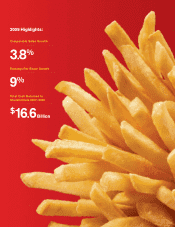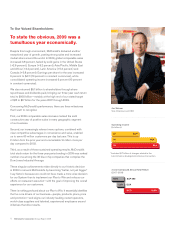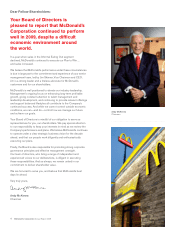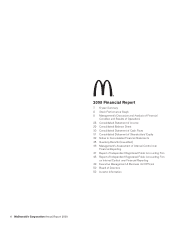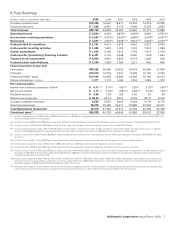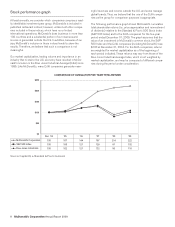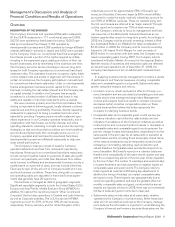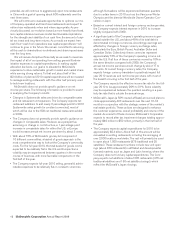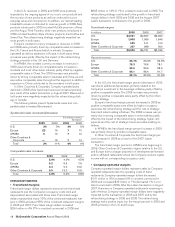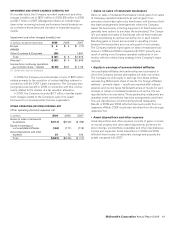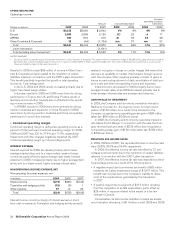McDonalds 2009 Annual Report Download - page 12
Download and view the complete annual report
Please find page 12 of the 2009 McDonalds annual report below. You can navigate through the pages in the report by either clicking on the pages listed below, or by using the keyword search tool below to find specific information within the annual report.basis on which the Company calculates and records franchised
revenues and are indicative of the financial health of the fran-
chisee base.
• Return on incremental invested capital (ROIIC) is a measure
reviewed by management over one-year and three-year time
periods to evaluate the overall profitability of the business
units, the effectiveness of capital deployed and the future allo-
cation of capital. The return is calculated by dividing the
change in operating income plus depreciation and amortization
(numerator) by the adjusted cash used for investing activities
(denominator), primarily capital expenditures. The calculation
assumes a constant average foreign exchange rate over the
periods included in the calculation.
STRATEGIC DIRECTION AND FINANCIAL PERFORMANCE
The strength of the alignment between the Company, its franchi-
sees and suppliers (collectively referred to as the System) has
been key to McDonald’s success over the years. This business
model enables McDonald’s to consistently deliver locally-relevant
restaurant experiences to customers and be an integral part of
the communities we serve. In addition, it facilitates our ability to
identify, implement and scale innovative ideas that meet custom-
ers’ changing needs and preferences.
McDonald’s customer-focused Plan to Win—which is cen-
tered around being better, not just bigger—provides a common
framework for our global business yet allows for local adaptation.
Through the execution of multiple initiatives surrounding the five
key drivers of exceptional customer experiences—People,
Products, Place, Price and Promotion—we have enhanced the
restaurant experience for customers worldwide and grown sales
and customer visits in each of the last six years. This Plan, cou-
pled with financial discipline, has delivered strong results for
shareholders.
We have exceeded our long-term, constant currency financial
targets of average annual Systemwide sales growth of 3% to
5%; average annual operating income growth of 6% to 7%; and
annual returns on incremental invested capital in the high teens
every year since the Plan’s implementation in 2003, after adjust-
ing 2007 for the Latin America developmental license
transaction. Given the size and scope of our global business, we
believe these financial targets are realistic and sustainable, while
keeping us focused on making the best decisions for the long-
term benefit of shareholders.
In 2009, we continued to elevate the customer experience by
remaining focused on the Company’s key global success factors
of branded affordability, menu variety and beverage choice, con-
venience and daypart expansion, ongoing restaurant
reinvestment and operations excellence. Locally-relevant ini-
tiatives around these factors successfully resonated with
consumers driving increases in sales, customer visits and market
share in many countries despite challenging global economies
and a contracting informal eating out market. As a result, each
reportable segment contributed to 2009 global comparable sales
and guest counts, which increased 3.8% and 1.4%, respectively.
In the U.S., we grew sales and market share with comparable
sales up for the 7th consecutive year, rising 2.6% in 2009. This
performance was the result of a continued focus on classic menu
favorites such as the Big Mac and Quarter Pounder, increased
emphasis on everyday affordability, and the national marketing
launch of the new McCafé premium coffees and premium Angus
Third Pounder. Complementing these efforts were our strategies
related to convenient locations, extended hours, efficient drive-
thru service and value-oriented local beverage promotions. In
conjunction with the introduction of the McCafé premium coffees,
reinvestment was needed in many restaurants to accommodate
the new equipment required to prepare these beverages as well
as facilitate the national introduction of smoothies and frappés in
mid-2010. In most cases, this reinvestment involved expanding
and optimizing the efficiency of the drive-thru booth, enabling us
to better serve even more customers faster.
In Europe, comparable sales rose 5.2%, marking the 6th
consecutive year of comparable sales increases. This perform-
ance reflected Europe’s strategic priorities to upgrade the
customer and employee experience, enhance local relevance,
and build brand transparency. Initiatives surrounding these prior-
ities encompassed: leveraging our tiered menu featuring locally
relevant selections of premium, classic core and everyday afford-
able menu offerings as well as dessert and limited-time food
promotions; and reimaging nearly 900 restaurants including
adding about 290 McCafés—an upscale area with coffeehouse-
style ambiance inside an existing McDonald’s restaurant. In
addition, we addressed growing interest in portable snack offer-
ings with platforms such as the Little Tasters in the U.K.,
launched breakfast in Germany and increased our convenience
with extended hours. In order to support greater menu variety, we
completed the roll-out of a new more efficient kitchen operating
system in substantially all of our European restaurants. Finally, we
enhanced customer trust in our brand through communications
that emphasized the quality and origin of McDonald’s food and
our sustainable business practices.
In APMEA, we continued to execute our four growth plat-
forms of breakfast, convenience, core menu and value.
Comparable sales rose 3.4% primarily due to the ongoing
momentum of our business in Australia where multiple initiatives
surrounding menu variety including the launch of the premium
Angus burger, greater convenience and reimaging further
strengthened our brand relevance. In addition, across the seg-
ment, we enhanced our convenience by increasing the number of
restaurants open 24-hours to over 4,600, expanding delivery
service to more than 1,300 locations including about 300 in
China, and enhancing drive-thru efficiency. We sustained the
momentum of our breakfast business, currently in about 75% of
our restaurants, by increasing customer awareness and visit fre-
quency with the launch of premium roast coffee in key markets
like Japan and China and promoting it through successful sam-
pling programs. We continued to appeal to customers with
branded affordability menus, especially our value lunch platforms,
and highlighted classic menu favorites like the Quarter Pounder.
Our customer-centered strategies seek to optimize price,
product mix and promotion as a means to drive sales and profits.
This approach is complemented by a focus on driving operating
efficiencies and effectively managing restaurant-level costs by
leveraging our scale, supply chain infrastructure and risk
management practices. Our ability to successfully execute our
strategies in every area of the world contributed to improved prof-
itability as measured by combined operating margin of 30.1% in
2009, an improvement of 2.7 percentage points over 2008.
Strong global performance positively impacted cash from
operations, which totaled $5.8 billion in 2009. Our substantial
cash flow, strong credit rating and continued access to credit
provide us significant flexibility to fund capital expenditures as
well as return cash to shareholders. About $2.0 billion of cash
10 McDonald’s Corporation Annual Report 2009


